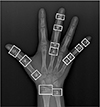Abstract
Objective
Methods
Results
Conclusions
Figures and Tables
 | Figure 1Cephalometric analysis. A, Cephalometric landmarks. S, Sella turcica; N, nasion; Ar, articulare; ANS, anterior nasal spine; PNS, posterior nasal spine; A, point A; B, point B; AO, the point perpendicular to the occlusal plane at point A; BO, the point perpendicular to the occlusal plane at point B; Go, constructed gonion; Me, menton; Pog, pogonion; Gn, mechanical gnathion. B, Linear measurements. AO-BO, Wits; N-Me, anterior facial height; ANS-Me, lower anterior facial height; S-Go, posterior facial height; N-Go, facial depth; S-Gn, facial length. C, Angular measurements. SNA, The relationship of the maxilla to the cranial base; SNB, the relationship of the mandible to the cranial base; ANB, the relationship between the maxilla and the mandible; SN-GoMe, mandibular plane angle; Ar-Go-Me, gonial angle; Ar-Go-N, upper half of the gonial angle; N-Go-Me, lower half of the gonial angle. |
 | Figure 2Thirteen measurement points on the hand using the Tanner–White III method.1, Radius; 2, ulna; 3, metacarpal I; 4, metacarpal III; 5, metacarpal V; 6, proximal phalange I; 7, proximal phalange III; 8, proximal phalange V; 9, middle phalange III; 10, middle phalange V; 11, distal phalange I; 12, distal phalange III; 13, distal phalange V.
|
Table 1
Sample characteristics

Values are presented as mean ± standard deviation.
Age (Lat), Chronological age at which lateral cephalometric radiographs were obtained; Age (HW), chronological age at which hand-wrist radiographs were obtained.
p-value of Age (Lat) was calculated with one-way analysis of variance.
p-values of Age (HW) and mandibular plane angle were calculated using the Kruskal–Wallis test with Bonferroni correction.
***p < 0.001.
Table 3
Angular cephalometric measurements

Values are presented as mean ± standard deviation.
Bjork sum, Sum of saddle angle (N-S-Ar), articular angle (S-Ar-Go), and gonial angle. Please refer to Figure 1 for abbreviations and definition of the variables.
***p < 0.001.
One-way analysis of variance with Bonferroni post-hoc test was performed.




 PDF
PDF ePub
ePub Citation
Citation Print
Print






 XML Download
XML Download